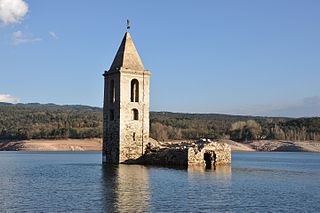
The comarques of Catalonia, often referred to in English as counties, are an administrative division of Catalonia. Each comarca comprises a number of municipalities, roughly equivalent to a county in the United States. Currently, Catalonia is divided into 42 comarques and Aran, considered a "unique territorial entity" and not a comarca.

Catalan cuisine is the cuisine from Catalonia. It may also refer to the shared cuisine of Northern Catalonia and Andorra, the second of which has a similar cuisine to that of the neighbouring Alt Urgell and Cerdanya comarques and which is often referred to as "Catalan mountain cuisine". It is considered a part of western Mediterranean cuisine.

Valls is a city and municipality in the Camp de Tarragona region in Catalonia, Spain. It is the capital of the comarca of Alt Camp, and according to the 2014 census it has a population of 24,570.

Mollerussa is the capital of the comarca of Pla d'Urgell, in the province of Lleida, Catalonia, Spain. It is 250 metres above sea level. In 2010 it had a population of 14,733.

Josep Bargalló i Valls is a Spanish teacher and politician from Catalonia and the current Minister of Education of Catalonia.

One of the first streams of Romanesque architecture in Europe from the 10th century and the beginning of 11th century is called First Romanesque or Lombard Romanesque. It took place in the region of Lombardy and spread into Catalonia and into the south of France. Its principal decoration for the exterior, bands of ornamental blind arches are called Lombard bands. It was characterized by thick walls and lack of sculpture in facades, and with interiors profusely painted with frescoes.

Jordi Bolòs i Masclans is Professor of Medieval History at the University of Lleida. Rural Catalan history, urban history and the landscape history has focussed his research in the study of the medieval society. He has published several historical atlases of the Carolingian counties of Besalú, Empúries-Peralada, Girona, Osona, Manresa, Urgell and Roussillon, Conflent, Vallespir and Fenouillèdes. Editor of the publication Territori i societat a l’edat mitjana.

The first names, or glossonyms, of the Catalan/Valencian language formed in a dialectal relation with Latin, in which Catalan existed as a variety. These names already expressed the relationship between the two languages. New names that related Catalan to Rome came about to dignify the Catalan language in the thirteenth century, though Latinists called it vulgar and the people planus, or pla.

The old church of Sant Romà de Sau is an 11th-century Lombard Romanesque parish church of the abandoned old village of Sant Romà de Sau in the municipality of Vilanova de Sau, Osona county, in the mountain region of the Guilleries, Catalonia, Spain. Consecrated in 1062 and submerged in 1962 through the completion of the Sau Reservoir on the river Ter, the church has been recognised as the oldest standing submerged church worldwide by the Official World Record Organisation. While the historic church and village, normally 23 metres underwater, can be reached on foot during dry periods, the tip of the church's iconic bell tower is invariably visible above the surface, serving as a popular indicator of the level of water resources.

La Vall de Bianya is a municipality of the comarca of Garrotxa, Catalonia. It is formed by eleven villages scattered around the Bianya and Bac valleys. The seat of the municipal government is in L'Hostalnou de Bianya, and the village with more inhabitants is La Canya. This latter village is divided between the municipalities of La Vall de Bianya and Sant Joan les Fonts. The municipality is part of the Zona Volcànica de la Garrotxa Natural Park and the Alta Garrotxa Consortium.

Maria Mercè Roca i Perich is a Catalan writer and politician from Spain. She was deputy to the Parliament of Catalonia for Republican Left of Catalonia, and currently serves as a councillor at the City Council of Girona for the same party.

The Army of the Principality of Catalonia was the army raised by the Junta de Braços of Catalonia on 9 July 1713 after the Peace of Utrecht and the withdrawal of the army of the Holy Roman Empire by the L'Hospitalet Agreement. The army was made up of 10,000 infantry, 1,600 cavalry and 1,000 naval troops. It is not known how many men formed the artillery unit but it did not exceed 700. In total, the army contained 13,000 regular troops.

The Veraza Culture was a Chalcolithic culture that extended over the half north of Catalonia and the southern French departments of Aude and Pyrénées-Orientales, in a period between 3500 and 2000 BC.

The Sepulcres de Fossa culture, was established in Catalonia in the Middle Neolithic and remained there until the beginning of the third millennium BC. Although initially this culture was linked to the Almeria culture, nowadays it is believed that it was related to the Cortaillod culture of Switzerland, the Lagozza culture of northern Italy, and the Chasseen culture found in French territory.

Named after its regional range, the Levantine Bronze Age refers to a culture extended over the actual territory of the Valencian Community, in the "Levante" or eastern side of the Iberian peninsula. Its chronological range was between 2200 BC and 1500 BC.

The Pyrenean Bronze is an archaeological facies that spread through the Spanish provinces of Girona, Barcelona, Lleida and the eastern half of Huesca; also it spread through the French departments of the Pyrenees-Orientales and Aude.















